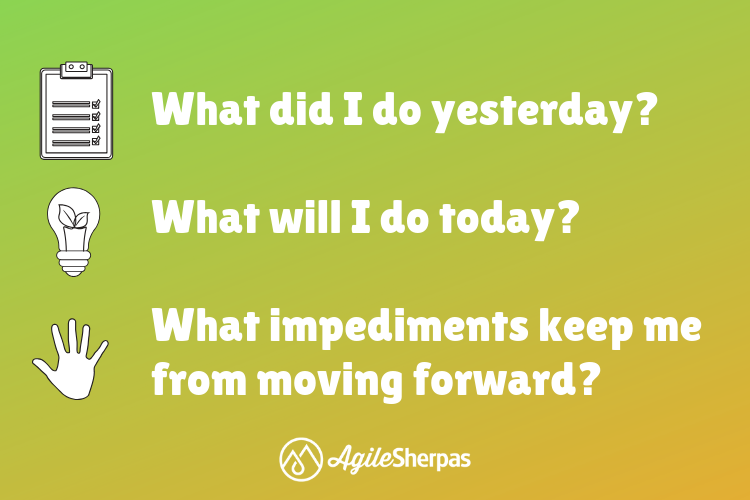Agile frameworks can be overwhelming to marketers encountering them for the first time, so it’s no wonder the simplest practices have the highest adoption rates.
Few things are simpler (at least on the surface) than the daily stand up, making it one of the first rituals to make it into a new Agile team’s day-to-day routine.
Our research for this year’s State of Agile Marketing Report shows that the daily standup is the most popular Agile technique used in marketing departments.
Practicing daily stand ups is even more popular than user stories, retrospectives and WIP limits, practices that also have their fair share of fans in the Agile marketing universe.

Daily standups may be popular, but that doesn’t mean everyone is getting them right. Done wrong these meetings can kill the spirit of a new Agile marketing team. Here’s how to keep that from happening to you.
What’s a Standup Anyway?
At their core, stand ups are daily meetings during which the team convenes for a brief status update. They stand to keep the meeting short, hence its name.
During the meeting, each team member spends 1-2 minutes maximum addressing the following:

Sounds simple, right?
Unfortunately, the definition that has made its way into the marketing lexicon is abridged. It fails to capture the subtle differences that distinguish between a stand up with purpose and a complete waste of time for the team.
When stand ups go right, they can become a truly loved team event that acts as an essential daily touchpoint and feedback loop between collaborators.
But, when teams integrate the stand up into their daily process before really understanding how to do it right, it can result in some real damage to the team dynamic.
Having worked with marketing departments in enterprises, SMBs as well as startups, the AgileSherpas team has seen a fair number of stand up “best practices” go awry.
So to help more marketers avoid the common mistakes associated with this awesome Agile practice, we decided to compile a list of some of the no-nos that we see all the time.
If you’re running a daily stand up with your team in any context, continue reading to make sure you’re not falling into any of the common traps that might hurt your team.
Don’t put a price on punctuality
In our experience, this practice is most prevalent among start ups. These teams are often small and chaotic, which translates into, “What is this ‘process’ you speak of?”
However, they are also keen to find ways to “hack” their productivity. One way to do this is to develop increased accountability with each other because they don’t have a long history of working together.
Groups like this love the daily stand up.
Unfortunately, startup teams are not used to being in the same place at the same time every single day. So, the stand up often gets delayed, only includes a fraction of the team, and/or eventually becomes ad hoc.
Their solution? Paying a toll for every minute you’re late.
(Yes, this happens.)
Clocking in at $1 - $5 per minute, the monthly fines for being late to standup can add up to several hundreds of dollars.
Punctuality for a stand up is key, but putting a price on it makes the entire idea of stand up very stressful (and expensive).
Being on time should come from the team and their dedication to being on track with each other’s work, not losing money.
Rather than charge late comers an actual fine, use the public nature of the standup meeting to call attention to their behavior. The team should self regulate and eventually stop tolerating tardiness.
Avoid the student-teacher dynamic
Don’t turn the stand up into a classroom by having the team lead or manager call on people to share an update.
Although, at first glance, this call and response creates the illusion of necessary order that will prevent the stand up from dragging along, it actually takes away agency from the team members.
The stand up is not meant to be a meeting in which team members report on their progress so a manager can keep tabs on who is slacking.

Having a team lead select the order makes it seem exactly like that.
The best stand ups develop a flow in which the initiative being discussed dictates the order in which team members take their turns.
This helps the group focus on actively listening to insight about the tasks being worked on within the team, rather than worrying about whether the’ll be called next.
“Two pizza” standups at most
When it comes to stand ups, size matters.
The Jeff Bezos rule for team sizes applies very well to stand ups as well.
Keeping standups to a group size that could hypothetically be fed with two large pizzas is ideal.
Having participated in a stand up with thirty people in it, I can tell you, there are many reasons that keeping stand ups to a maximum of about a dozen people makes them much more effective and efficient.
Here are a few of the reasons “big room” stand ups that include everybody and their cousin don’t work in the real world:
- The meeting always takes longer than expected
- Everyone is less encouraged to share blockers in a room of 30 people
- People skim over important issues to “not take up too much time”
- Team members not collaborating closely tune out after their turn
- Too many irrelevant details distract some members from their tasks on deck
Keep stand ups small, short, and sweet.
Be visual
One of the worst tendencies I’ve observed (and also practiced the first time I had to do a daily stand up) was something I called pulling a “Valedictorian.”
The behavior is common among Type-A high achievers, but left unchecked can infect a whole team.
It goes like this. You spend the first thirty minutes of your work day before daily stand up crafting three perfect sentences to encapsulate the amazing things you’re working on.
You make sure they make your time and results sound as awesome as possible.
Then, you write some notes to take into the meeting with you to make sure your don’t stumble on your prepared words.
You wait for your turn, hoping it doesn’t sound like everyone is moving forward faster on their initiative. You’re so concerned about what you’re going to say that you can’t focus on anybody else’s updates.
Doing stand ups this way generates a lot of anxiety among team members and might result in a misrepresentation of the status of their work items.
If you’re using a visual board to track your team’s tasks, host your stand up in front of it and use it to dictate the agenda of the meeting.

Let your team’s visual workflow speak for your results and blockers. No matter whether you’re using a physical board with post-its (pictured above) or a digital board on a huge flatscreen, use it as a radiator of information about the status of your tasks.
This is especially when communicating your progress and impediments to your team.
Remember, this is not a presentation or a chance to show off. These are your teammates and the stand up is one of your collaboration channels.
Include everybody
In a profession in which remote working is becoming more and more prevalent, it can be difficult to get every team member in the same physical space for stand ups.
Luckily, technology lends us a hand here.
We have hundreds of completely free and accessible ways to connect with our team members for 15 (ish) minutes each day. Google Hangouts, Skype, and Zoom are just three examples of ways we can include remote team members in our daily stand ups.
If you can’t get everyone who works together on a call once a day, there are alternative scheduling options.
For example, if you’re working with freelancers or external agencies, make sure they join your team’s stand up once a week to keep them in sync with the internal team members.
If you’ve got team members from many time zones working on the same project, tools such as Status Hero can help the stand up carry on online.
Whatever you do, don’t let distance derail your standups. Adhere to best practices and lean on technology as needed.
Remember Why We Standup
When starting out with Agile practices, it’s easy to integrate a new ritual, like daily stand ups, into your team’s day-to-day routine.
You should absolutely start experimenting with the powerful meeting ASAP, just make sure you’re doing it right from the outset so that your team gets the full benefits of this technique.
That’s when you’ll really feel an improvement in daily communication.
After you’ve got the basics down pat, there are tons of ways you can build upon your stand ups to make them even more fun and effective.
Is there a “best practice” for stand ups you’ve already discovered with your team?
Let us know in the comments and share it with the world.



